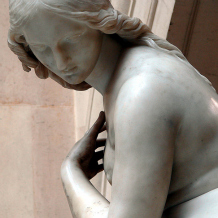Period Band C
Victorian Sculpture
Tutor: Jason Edwards
Description
The aim of this module is to introduce students to the major trends in sculpture in Britain between the arrival of the Elgin Marbles in London and the death of Queen Victoria.
Sculpture could be found everywhere in Victorian Britain: in galleries, museums, and great exhibitions; in homes, parks, gardens and city squares; incorporated into a wide range of buildings, furnishings and other decorative objects; and depicted in a diverse array of other media. In spite of this, and while Victorian Studies has undergone a remarkable growth in the past two decades, with exhaustive research into many aspects of nineteenth-century British culture, scholars have almost entirely overlooked Victorian sculpture, perhaps the single most significant art form in Britain in this period. This module seeks to return Victorian sculpture to centre stage in discussions of nineteenth-century Britain, and to illuminate the complex ways in which it functioned, and continues to function, aesthetically, politically, socially and historiographically.
Objectives
By the end of the module, students should have acquired:
- familiarity with a wide range of sculpture produced and exhibited in the period
- an ability to relate works of sculpture to a broad range of cultural historical issues, and political agendas, such as race, gender, and sexuality; and to other visual, literary and scientific texts
- an understanding of the main historiographical and theoretical approaches to the sculpture in this period, particularly its difficult position between eighteenth-century sculptural aesthetics and Modernism
Preliminary Reading
As you prepare for the course, think about some of the following issues:
- the relationship between form and materiality, meaning and matter; opticality, mass and tactility; plane, contour, multi-faciality, detail, relief and three-dimensionality;
- the question of ‘aura’ in relation to sculpture’s inherent reproducibility, workshop production, and status as a modern industrial medium;
- the particular problems of sculptural production, patronage and exhibition in the nineteenth century;
- the relationship of sculpture to literary narrative and the particular problems of sculptural ekphrasis;
- the diverse and changing languages of classicism informing the sculptural encounter deriving from the mid- to late-eighteenth century, and their ongoing mediation of baroque aesthetics;
- sculpture’s relation to other media and objects, especially industrial, decorative and applied arts objects;
- sculpture’s position in domestic, local, regional, national, cosmopolitan and imperial cultures;
- how we understand the ‘Victorian’ in Victorian sculpture, especially the questions of sentimentality, monumentality, sexual repression, and Victorian sculpture’s problematic status as ‘kitsch’;
- the question of sculptural modernity and Victorian sculpture’s position, as a foil, within the genealogy of modernism;
- the limitations and possibilities attendant upon the fact that most of our sculptural encounters this term will take place with monochrome photographs and engravings rather than with objects
- Atterbury, Paul. The Parian Phenomenon (1989).
- Barnes, J. (ed.) Pre-Raphaelite Sculpture (1991).
- Barnes, Richard. John Bell: The Sculptor’s Life and Works (1999).
- Barringer, Tim. ‘Colonial Gothic’, Men at Work: Art and Labour in Victorian Britain (2005), 243-313.
- Baxandall, Michael. The Limewood Sculptures of Renaissance Germany (1980).
- Beard, Geoffrey W. The Work of Grinling Gibbons (1990).
- Berstein, Susan David and Elsie B. Michie eds, Victorian Vulgarity: Taste in Verbal and Visual Culture (2009).
- Blake Roberts, Jaye. Wedgwood Jaspar Ware.
- Bluhm, Andreas. The Colour of Sculpture 1840-1910 (1996).
- Cecil, Victoria. Minton Majolica.
- Chakravarty, Gautam. The Indian Mutiny and the British Imagination (2005).
- Clerbois, Sebastien. Heart of Darkness: Ivory Carving and Belgian Colonialism (2008).
- Copeland, Robert. Parian: Copeland’s Statuary Porcelain (2006).
- Cunningham, Colin. The Terracotta Designs of Alfred Waterhouse (2001).
- Dehijia, Vidya. Delight in Design: Indian Silver for the Raj (2008).
- De Margerie, L et al (eds), Facing the Other: Charles Cordier (1827-1905): Ethnographic Sculptor (2005), 1-129.
- Droth, Martina et al. Sculpture Victorious: Art in an Age of Invention, 1837-1901 (2014).
- Esterley, David. Grinling Gibbons and the Art of Carving (1998).
- Getsy, David. J. Body Doubles: Sculpture in Britain, 1877-1905, chapter on Gilbert.
- Gilroy, Paul. The Black Atlantic: Modernity and Double Consciousness (1993).
- Green, David Bronte. Grinling Gibbons: His Work as a Carver and Statuary 1648-1821 (1964).
- Hawkins, J.B. Nineteenth-Century Australian Silver (1990).
- Keller, Ulrich. The Ultimate Spectacle: A Visual History of the Crimean War (2001).
- Markovits, Stefanie. The Crimean War in the British Imagination (2009).
- Morris, Robert. ‘Notes on Sculpture’ (1967), in Harrison and Wood (eds), Art in Theory 1900-1990 (1988), 813-22, 863-73.
- Nelson, Charmaine. The Colour of Stone: Sculpting the Black Female Subject in Nineteenth-Century America (2007).
- Pietz, W. ‘Fetish’, in Nelson and Schiff (eds)., Critical Terms for Art History (1996), 197-208.
- Pugin, A.W.N. Contrasts (1833).
- Read, Benedict. Victorian Sculpture (1983), 1-200.
- Revell, James. Complete Guide to the Ornamental Leather Work (London, c.1862),
- Rogers, L.R. Relief Sculpture (1974).
- Ruskin, John. ‘On the Nature of Gothic’ (1853), The Stones of Venice and various editions of selected writings.
- Stewart, Susan. ‘The Miniature’, ‘The Gigantic’, On Longing (Durham, 1993), 37-104.
- Summers, David. ‘Form and Gender’, in Bryson et al (eds), Visual Culture: Images and Tipping, Henry Avray. Grinling Gibbons and the Woodwork of his Age, 1648-1720 (1914).
- Wallis, Thomas Wilkinson. Autobiography of Thomas Wilkinson Wallis (1899).
- Wood, P. ‘Commodity’, in Nelson and Schiff (eds) Critical Terms for Art History (1996). 257-81.

